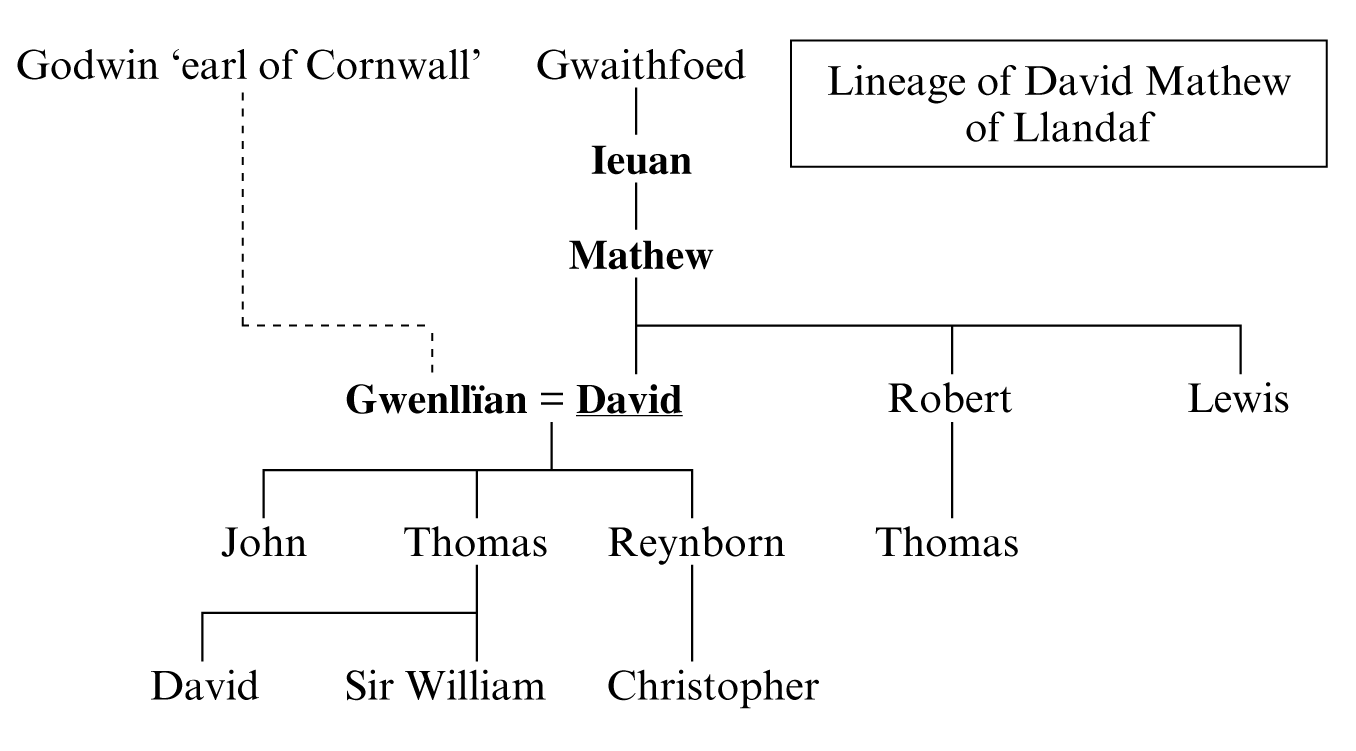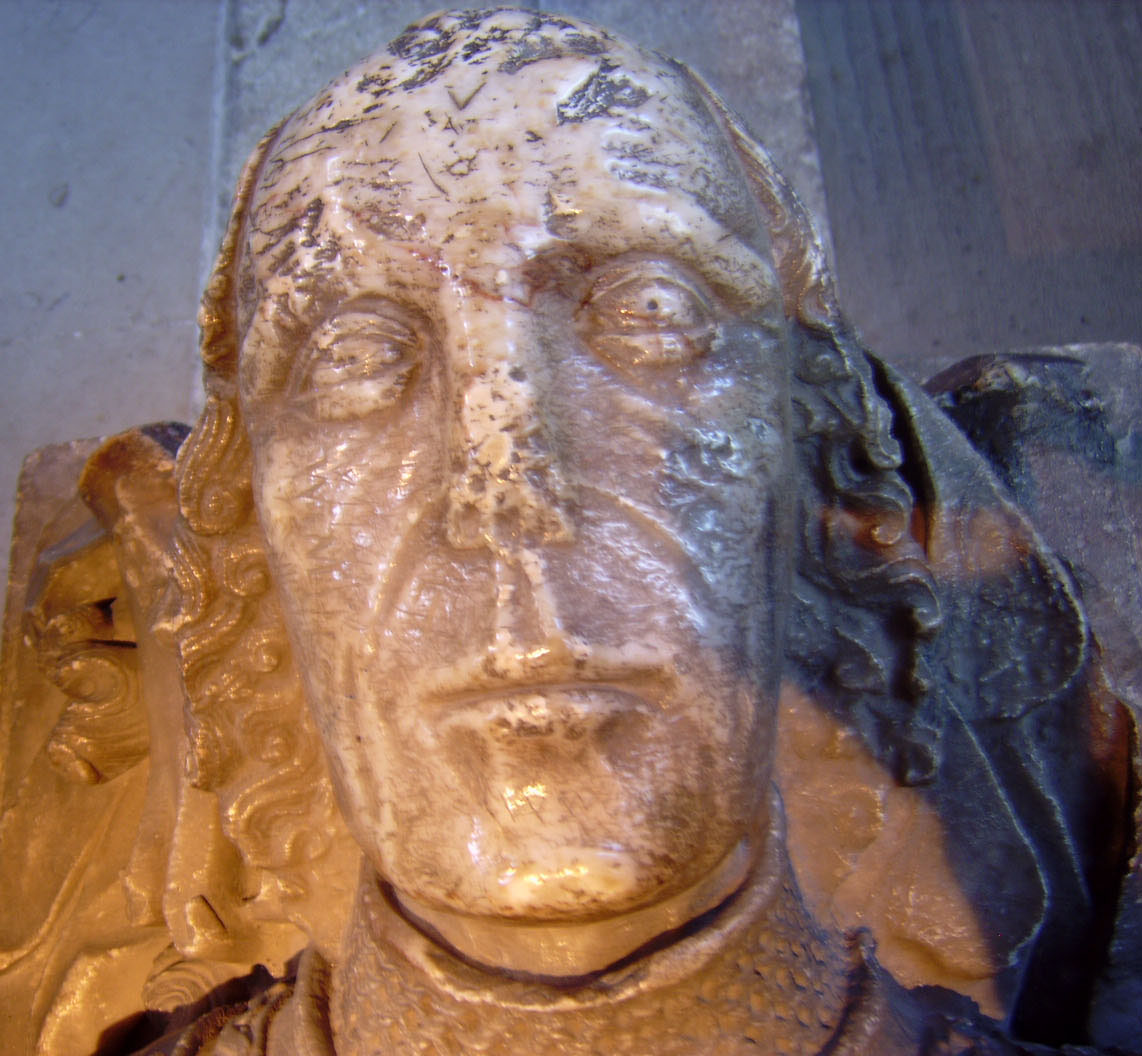David Mathew was the patron of poem 17, which gives the following information about its recipient: i. his name, Dafydd Mathau (David Mathew); ii. he is connected with Cardiff and Glamorgan, and more particularly with Llandaf; iii. his hair is black; iv. he is married to a woman called Gwenllïan; v. he is the son (it seems) of a Mathau ab Ieuan, who is dead; vi. his father’s property has been divided among three men, namely David Mathew himself and his two brothers, in all likelihood; vii. he has four sons.
Lineage
David Mathew’s pedigree is given in WG1 ‘Gwaithfoed’ 4 and 5, and his wife’s in ‘Godwin’ 4. Here is a shortened version (those named in Guto’s poem are shown in bold print, and the patron’s name is underlined):

Lineage of David Mathew of Llandaf
He did indeed have two brothers, namely Robert and Lewis, which agrees with what Guto implies, and Lewis Mathew received an elegy by Hywel Swrdwal (GHS poem 10).
His dates
WG1 allots to David Mathew the dates 1425–94, without citing his source. In GGl2 346 he is said to have died in 1504. This is not correct: 1504 was actually the death date of his grandson, David Mathew son of Thomas Mathew son of David Mathew: the will of this David Mathew survives, dated to that year (GIF 118; Matthews 1903: 102); he was buried in London. In DWB 618 the death of the elder David Mathew is placed in 1484, but in Butler 1971: 410 it is given as 1461. Neither gives a source for the date.
David Mathew’s name is found in records between the years 1424–48. In 1424 he witnessed a charter given by Richard Beauchamp, earl of Warwick, in Cardiff. In 1427 he is named as a landholder in Coety. In 1431 he, along with his two brothers, witnessed a transfer of lands in Nash, and the same three men also witnessed a lease of lands to the same man, Hywel Carn, in the same place in 1432. David Mathew is named again as a free tenant in 1437. In 1440 he witnessed the restitution of lands in the lordship of Ogmore to Margam Abbey. In 1448 he, along with his brother Lewis Mathew and the son of his other brother, Thomas son of Robert Mathew, witnessed a lease of land in Nash. For the references, see GHS 163; Clark 1893–1910, iv: 1513–19, 1528–30, 1545, 1551; Butler 1971: 637, note 162; Clark 1893–1910, iv: 1561, 1608.
In an inquisition upon the property of Sir George Mathew, held in 1559, we find details of the family’s early history and properties. The account notes that the manor of Corntown was given to David Mathew and his wife Gwenllïan in 1435, and that it was to descend to their son Thomas after their deaths, or to another son, John, if Thomas should die without issue before then (Matthews 1898–1911, iii: 82–6). More interestingly, there is also an account of a deed dated to 1458 which transferred the manors of Peterston and Glaspole to John Neville (the son of Richard Neville, earl of Warwick) and to David Mathew and his son Thomas, both knights, to descend to Reynborn Mathew, another son of David Mathew, or his heirs, if Thomas’s line should die out. So David Mathew still lived in 1458. Thomas, however, was never a knight. He was still an esquire when he died (Matthews 1898–1911, iii: 102). As to whether David Mathew was knighted, all that can be said is that he was not yet a knight when Guto’r Glyn composed his poem. It is quite incredible that a Welsh praise poet would not mention that his patron had been dubbed.
Thomas and Reynborn, sons of David Mathew, died in short succession in 1470. It seems that both then were living in Bristol, and both were buried in St Mark’s, also known as Gaunt’s Hospital, in that city. In Reynborn’s will there is mention of lands in Coety and Glynogwr which he had inherited from his father. There is also mention of a chantry established in Llandaf cathedral under the terms of David Mathew’s will (Matthews 1903: 102). David Mathew therefore died before 1470. Details about the chantry of David Mathew are found in a survey made in 1546 when it was still being maintained (Jones 1934: 148–9; thanks to Dr Katharine Olson for the reference).
His tomb
There is a tradition that David Mathew’s tomb is still to be seen in Llandaf cathedral. Only the effigy survives today, mounted on a plain plinth (Bardo and Gray 2007: 16, DWH i: 240).

Supposed effigy of David Mathew in Llandaf cathedral. Photo: Barry J. Lewis.
The rest of the tomb, described in Browne Willis’s survey of the church in 1719, has vanished. It appears that even then there was no inscription:
This is said to be the Monument of David Matthew the Great, who was Standard-Bearer to Edward IV, and was murther’d at Neath ... by some of the Turberviles, with whom he was at Variance (Willis 1719: 25).
Richard Symonds noted the tomb in 1645, attributing it to ‘great David Mathew, standard bearer to K.’, but without naming the king (Lang 1859: 213). Though there is no inscription to prove that the effigy represents David Mathew, it is clear that members of the family were buried in the cathredal. The tombs of Sir William Mathew, the brother of the younger David Mathew, and of Christopher Mathew (son of Reynborn son of David Mathew) stand nearby, their inscriptions confirming their identity. As to the colourful details given by Browne Willis, they have to be left unconfirmed, since there is no other evidence for them.
His patronage of poetry
No other poems have survived for David Mathew. There is a poem by Llawdden for a certain David Mathew, which opens as follows:
Duw a rannodd drwy einioes
Dau Ddafydd, Mathau, i’m oes:
Un a fu’n dda ’n ei fywyd,
Arall a fag yr holl fyd (GLl 27.1–4).
It is virtually certain that the grandson, the younger David Mathew, was the true recipient of this poem, not the David Mathew in whom we are interested. The editor of GLl believed that the ‘two Dafydds’ in line 2 are David Mathew (son of Mathau ab Ieuan) and his father-in-law, Dafydd ap Gwilym: but the (editorial) comma after Dafydd is very awkward, and if we recall that there were indeed two men called Dafydd Mathau, the grandfather and the grandson, then we can dispense with it. This is how the lines should be translated:
God has granted, over my lifetime,
Two David Mathews:
One used to be very comfortably off,
The other can feed the whole world.
The poet is talking about having seen two David Mathews in his lifetime. Of these, one is dead, as the past tense in line 3 shows. The other is the recipient of the poem. This also explains why the patron is described as gwaladr (‘chieftain of’) Dafydd ap Gwilym and as Llwyth Godwin (‘of the lineage of Godwin’). This refers to the ancestry of the elder David Mathew’s wife, as the editor noted, but expressions of the kind ‘noun + ancestor’s name’ in medieval Welsh poetry usually imply a blood-link, not merely a link through marriage. This difficulty disappears once we understand that it was the younger David Mathew, grandson of the elder and his wife Gwenllïan, to whom Llawdden addressed himself. The poem was undoubtedly composed after 1469, since the poem names Watkin ap Thomas ap Roger of Hergest as another patron, and he inherited Hergest after the death of his father at the battle of Banbury in 1469 (GLl 7). That agrees with the evidence of Reynborn Mathew’s will, according to which David Mathew must have died before 1470.
Acknowledgement
I wish to thank Rhianydd Biebrach for her help with some of the above points and especially for showing me copies of the wills of Thomas and Reynborn Mathew.
Bibliography
Bardo, D. and Gray, M. (2007), ‘The Power and the Glory: The Medieval Tombs of Llandaff Cathedral’, The Welsh Journal of Religious History, 2: 6–26
Butler, L.A.S. (1971), ‘Medieval Ecclesiastical Architecture in Glamorgan and Gower’, in T.B. Pugh (ed.), Glamorgan County History, iii: The Middle Ages (Cardiff), 379–415
Clark, G.T. (1893–1910) (ed.), Cartae et Alia Munimenta quae ad Dominium de Glamorgancia pertinent (Cardiff)
Jones, E.D. (1934), ‘Survey of South Wales Chantries, 1546’, Arch Camb 89: 135–55
Lang, C.E. (1859) (ed.), Diary of the Marches of the Royal Army During the Great Civil War Kept by Richard Symonds (London)
Matthews, J.H. (1898–1911) (ed.), Cardiff Records (Cardiff)
Willis, B. (1719), A Survey of the Cathedral-church of Landaff (London)





